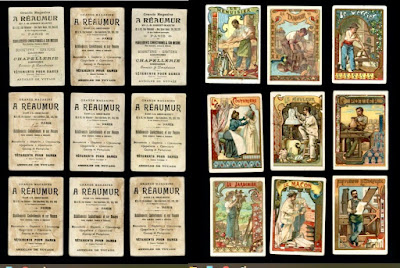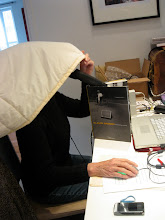Like everywhere else, France is subject to mad crazes that sweep in and capture everyone's imagination, and then, just as quickly, often vanish as fast as they appeared.
Back in 2012, people were scurrying around Paris looking for this new, exciting food truck that showed up in different neighborhoods at different days and times of the week. I wrote about this in a blog post at the time.
Lines would form around the truck, in fair weather or foul, as people waited up to 45 minutes for...
...The Authentic American Hamburger!! That was then. Today, eleven years later, burger joints are ubiquitous in Paris. There are at least four in our neighborhood. "Hot" back then, and still "Hot" today. I don't know what became of the truck.
The same cannot be said for the Bagel frenzy that followed a couple of years later. They showed up as solo stars of a bagel bakery, or teamed up with other breads, even brownies!
Today, you'd be hard pressed to find such a shop. Certainly, the two that used to be around us have long since disappeared. Clearly, it is a challenge to recreate that perfect New York bagel!
Some items are seasonally "Hot", like the gazillion Galette-de-Roi that celebrate the Day of Epiphany, marking the visit of the Three Kings to the Baby Jesus. Whoever finds the hidden "fève" gets to wear the crown for the day.
Earlier this month, mushrooms were definitely "Hot". Every greengrocer on the rue Montorgeuil had tables out front, groaning with their offerings: Oyster, Shiitake, White, Cremini, even some called "Pied- de-Mouton" (Sheep's foot!).
The other "Hot" item around the holidays and through the month of January, are Atlantic oysters! At our former favorite cafe, a table is set up out front, on the pavement, piled high with baskets of these delicious bivalves from Normandy.
I have to admit they are just as tasty and tangy as those grown and consumed around Tomales Bay!
Something new and definitely "Hot" has popped up this year on the rue d'Aboukir, the side street we look out on. A small, narrow storefront, bedecked with floral decorations recently opened, and attracts lines out the door, down the street, and at times, around the corner. Say hello to Fuumi Sushi Burrito!
Mexican meets Japanese! There's no tortilla. Instead, a square sheet of nori is placed on the counter, a layer of cooked white rice spread on top, followed by chopped vegetables, raw fish or cooked chicken or cooked beef, sliced avocado, chipotle mayo, chili paste, wasabi, tabasco and other spices. A sushi mat helps roll it up, and voilà, a super healthy lunch or dinner-time snack. (I did note that during evening hours, when presumably customers are largely adult, the signs outside displaying photos of the sushi-burritos take on a distinctly phallic shape, which might account for the large crowds. These photos do not appear in the daytime. As this is a public blog, I will refrain from posting them. Suffice to say, it is not subtle!)
Combining good food with a Parisian tour has produced another new (to us) item that seems to be popular with visitors. "Bustronome: Voyage Gastronome" is a way for a time-pressed tourist to combine a guided tour with a delicious meal.In the glass-domed upper level, customers can relax at elegantly laid tables, and, for 85 euros, enjoy a four course lunch, including wine, whilst the bus driver slowly wends his way by all the major city sights, and the tour guide tells you everything you need to know about them!
Turning to the world of fashion, there's only one thing that's "Hot" this year: BOOTS! But not the elegant, supple, ankle, knee or thigh-high boots of yore. This time around, it's what I might charitably describe as "clodhoppers" -- 3" to 4" ridged, rubber soles, or 4" high wooden heels, mostly black, some patent black, heavy brass grommets through which laces presumably hold the boot on the foot.
Frequently worn with skin tight, shiny leggings, tailored to look like black jeans, these boots are not "made for walking". They're the kind of footwear you might put on to go clomping across a muddy field in February, rather than trying to sashay down the rue Montorgeuil on a Friday evening! I predict by next year, they'll join the "what's not..." group, and be showing up in thrift shops all across town, at least I hope they will.
Someone we're always happy to see, and who could never not be "Hot" -- Chewbacca, standing guard at the Celio men's store in the Forum des Halles.And here's something we're seeing more and more of: 100% electric buses. Due to Covid, we've stayed away from taking public transportation most of the time, but it's good to see the direction the city has taken. We also notice fewer cars clogging the streets, partly due to people working remotely, but also a deliberate move by the Mayor of Paris, Anne Hidalgo, to reduce automobiles in the centre of town. All "Hot" stuff, for sure.
January 15 celebrated the 400th anniversary of the birth of Molière. As we walked back to our side of town that afternoon, we passed his statue on rue Richelieu.
We noticed a small group of older people gathered at the base of the statue. A demonstration? Or a celebration of the great man?
A very small demonstration, it turned out, pushing for the eradication of any "English-isms" that have crept into the French language. "It's French that's the language of the Republic, not English!" I fear that's a losing battle, although certainly the language of Molière continues to be a "Hot" item at the Comédie Française.
My final offering of what's "Hot" is this typical Haussmannian building at 82-92 rue Réaumur, just before it meets Boulevard Sebastopol. Definitely not "Hot" today, but from 1897 to 1960, it certainly was. A business man from Lorraine, Jean-Baptiste Gobert-Martin, acquired the site in 1896. By the following year, the building was complete, and opened its doors as "À Réaumur", a full-scale clothing store in the spirit of the other Grands Magasins of the era. Felix Fauré, then President of France, officiated at the opening. The store sold high quality ready-to-wear (prêt-à-porter) clothing at attractive prices, both in store, and by catalogs that came out with each season. It proved to be hugely successful.
How do I know all this? Well, when you look way up at the "prow" end of the building, you see this beautiful clock, colorfully decorated with fleur-de-lys in green and yellow enamel. Enlarging the photo, I saw the letters "A REAUMUR" surrounding the clock face, and above, in even smaller letters, the name "Gobert-Martin", and then his initials on the decorative cornice higher up on the building. A quick dip into the internet, and the above story revealed the history of this interesting man, who received the Légion d'Honneur, and the Mérite d'agricole in recognition of his productive life. If you walk by the building after a rain shower, and the sun comes out, the clock face gleams and sparkles like magic. It may no longer be a "Hot" item today, but it makes me smile every time, especially now that I know its history!
Speaking of shafts of sunlight, we caught this classic "God's light" beaming down on St. Eustache last week. No question, our view remains our favorite "Hot" item.À bientôt!



















































